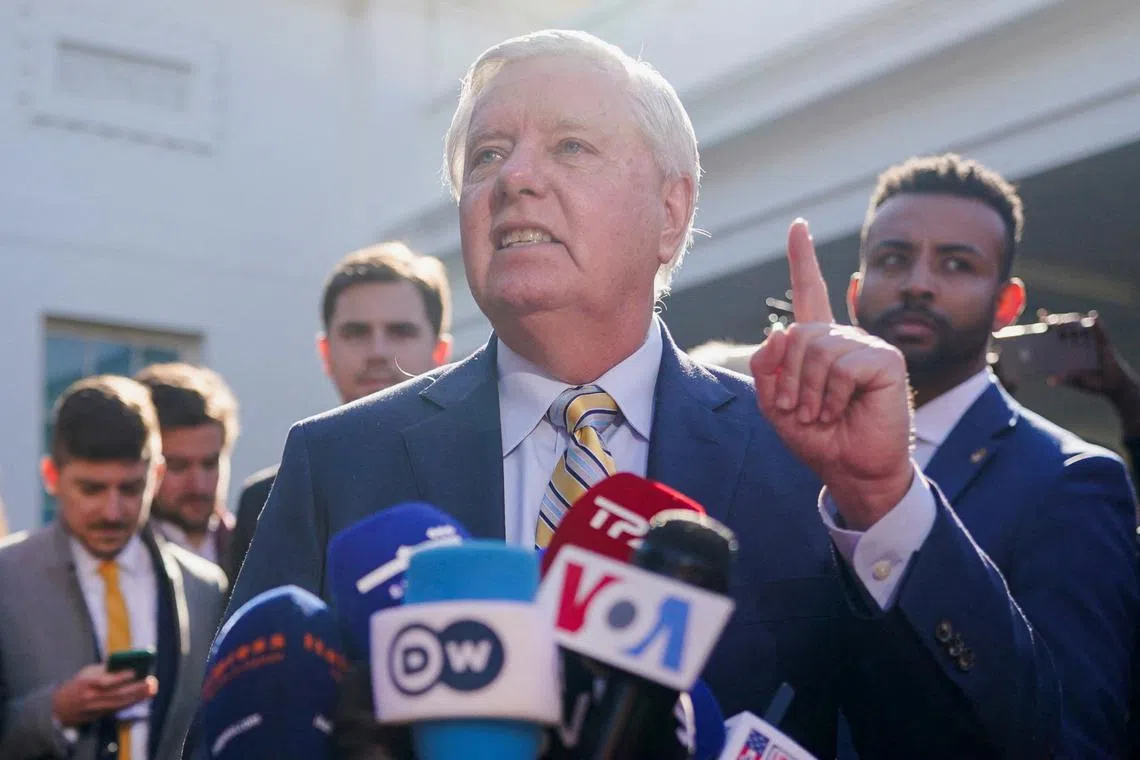US senators push Trump administration on Russian assets, says letter
Sign up now: Get ST's newsletters delivered to your inbox

In a letter, US Senator Lindsey Graham and other senators asked if the Trump administration intends to develop a strategy to encourage the EU, Group of Seven and other allies to leverage sovereign Russian assets.
PHOTO: REUTERS
Follow topic:
WASHINGTON – A group of Republican and Democratic US senators is pushing President Donald Trump’s administration to transfer – and push allies to transfer – more than US$300 billion (S$401.6 billion) of seized Russian assets to help Ukraine and not just use the debt’s interest to support Kyiv.
In a letter sent to Secretary of State Marco Rubio and seen by Reuters on March 24, the senators asked: “How does the administration view using all financial tools at its disposal to increase pressure on Russia to end the war?
“Specifically, does the administration believe that US and European Union-held assets should be used as leverage in negotiations with Russia to bring an end to the war? If so, how?”
The letter was signed by Republican senators Todd Young and Lindsey Graham, and Democrat senators Richard Blumenthal and Tim Kaine.
The letter is a rare example of senior Republicans publicly pressing the Trump administration to be tougher with Moscow.
Pro-Ukraine Republicans in Congress have been largely quiet since Mr Trump tilted US policy more towards Russia, which started the war with its full-scale invasion of Ukraine in 2022.
The State Department did not immediately respond to a request for comment.
The letter was sent on March 21. It comes as US and Russian officials held talks in Saudi Arabia on March 24 aimed at sealing a Black Sea maritime ceasefire deal before a wider ceasefire agreement to end the three-year-long war in Ukraine.
Members of the US Congress have been calling for years for seized Russian assets to be used to rebuild Ukraine, both to avoid spending more American taxpayer dollars on the conflict and to put pressure on Moscow to reach a peace deal.
In their letter, the senators asked if the administration intends to develop a strategy to encourage the EU, Group of Seven and other allies to leverage sovereign Russian assets. They also asked if the administration would support Ukraine using Russian sovereign assets under US control to purchase defence equipment.
After Russian President Vladimir Putin sent troops into Ukraine in 2022, the US and its allies prohibited transactions with Russia’s central bank and Finance Ministry, blocking US$300 to $350 billion of sovereign Russian assets.
They are mostly European, US and British government bonds held in a European securities depository. Sources said only about US$7 billion is held in US financial institutions.
Potential legal challenges
European leaders want to use those assets to help rebuild Ukraine, but have yet to reach an agreement on how to avoid legal challenges or set a problematic international precedent, with several options under consideration.
European and US officials have agreed to use windfall profits from interest on the frozen Russian assets to back loans to Ukraine, but not the assets themselves.
The lawmakers said they understood that the US also does not want to seize the assets themselves, and that they “seek to understand the administration’s position on this issue”.
Russia has said plans to use the funds for Ukraine amounted to robbery, although sources told Reuters in February that Moscow could agree to using assets frozen in Europe for reconstruction but would insist part of the money be spent on the one-fifth of the country that its forces control.
The US Congress in 2024 also passed the Rebuilding Economic Prosperity And Opportunity For Ukrainians Act, signed into law by former president Joe Biden that April. The legislation gave the US president the authority to transfer Russian assets seized in the US to Ukraine.
Washington has never before seized central bank assets from a country with which it was not at war. REUTERS

